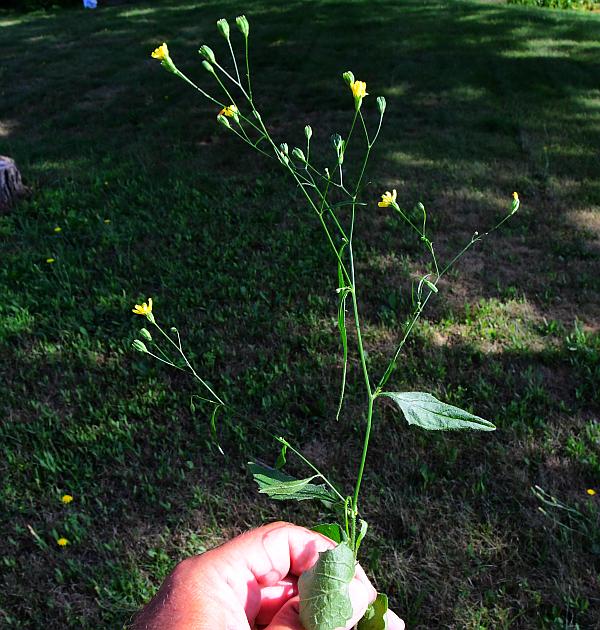Lapsana communis L.
Nipplewort

Introduced
CC = *
CW = 3
MOC = 4
© SRTurner
Lapsana communis L.Nipplewort | |
 |
Introduced CC = * CW = 3 MOC = 4 |
© SRTurner |
|
Family - Asteraceae/Cichorieae Habit - Annual forb with shallow, fibrous roots. Latex white. Stems - Ascending to erect, to 80 cm, sometimes multiple from the base, unbranched or few-branched below the midpoint, finely longitudinally ridged, sparsely to moderately pubescent with slender, multicellular, spreading hairs, these sometimes gland-tipped, especially toward the stem tip, occasionally nearly glabrous with age.
Leaves - Basal and alternate, sessile or with a short to long, winged petiole. Blades 1-15 cm long, those of the basal and lower stem leaves obovate to oblanceolate, with a large, ovate terminal lobe abruptly tapered to a narrower, pinnate series of lobes, these sharply triangular with mostly broadly rounded sinuses. Upper stem leaves mostly unlobed, entire or with few to several broad, shallow, spreading teeth, both surfaces sparsely to moderately pubescent with short, white, more or less spreading, nonglandular hairs. Venation of 1 main vein and a complex network of anastomosing secondary and tertiary veins.
Inflorescence - Loose terminal panicles or clusters, the heads appearing mostly long-stalked.
Heads - Ligulate. Involucre 5-10 mm long, cup-shaped, the bracts in 2 series, glabrous or inconspicuously cobwebby- or glandular-hairy along the margins, those of the outer series 4 or 5, 0.5-2.5 mm long, ovate to narrowly triangular, green; those of the inner series 8-10, narrowly oblong, usually becoming keeled as the fruits mature, sometimes becoming somewhat hardened and pale yellow at maturity. Receptacle naked. Ligulate florets 8-15, the corollas 7-10 mm long, lemon yellow to yellow. Pappus absent.
Fruits - Achenes 3-5 mm long (those of the outer florets longer than those of the inner ones), narrowly oblong in outline, often slightly flattened, with numerous fine ribs, somewhat curved, slightly tapered to a more or less truncate tip, not beaked, the surface otherwise smooth, glabrous, shiny, light brown to yellowish brown.
Flowering - June - September. Habitat - Streambanks, roadsides, open disturbed areas. Origin - Native to Eurasia. Lookalikes - Numerous other species within the Cichorieae tribe, including species of Crepis, Hieracium, Krigia, Leontodon, Hypochaeris, and others. Attention to detail is sufficient to enable confident distinction. Other info. - This introduced plant occurs sporadically throughout most of the continental U.S., but is uncommon to rare except in the Pacific Northwest and some New England regions. In Missouri it has been reported from only four widely scattered counties in the southern half of the state. The plant appears similar to many others in its tribe, but can be distinguished by its petioled leaves, small heads containing only a few florets, and the lack of a pappus on the florets. This last trait lends a distinctive appearance to the the fruting heads and the small "seeds" (actually fruits) contained within. Photographs taken near Woodinville, King County, WA, 6-14-2015, and near Fremont, Newaygo County, MI, 7-20-2022 (SRTurner). |